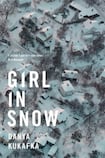
How young is too young to write a novel? How much life experience should a person have before setting out to explore human nature across three hundred pages? It would make an interesting subject for debate and one could certainly make a list of various wunderkinden who produced something outstanding while still in the first flush of youth. Jane Austen, after all, was only 19 when she wrote Sense and Sensibility, Bret Easton Ellis a year older when Less Than Zero was published. More recently, Zadie Smith began her career at 25 with White Teeth. Joining the young achievers' club now is Danya Kukafka who, at 24, has written a dark and unsettling account of Colorado life, billed as a thriller but really more of a three-character study, and one which, while written with great sensitivity and meticulous introspection, occasionally suffers under the weight of its own cheerlessness.
The novel opens with the discovery of the body of a popular teenage girl, Lucinda Hayes, and follows the reaction of three people connected to the victim. First, there is Cameron, a 15-year-old-boy, artistically gifted but with increasingly apparent mental health issues, who had been stalking Lucinda, watching her from afar night after night, stealing her diary and compulsively drawing images of his obsession that he stashes in his bedroom.
Then there is Jade, another high school girl who lives in a self-created cinematic world, seeing herself as the lead character in an ongoing drama and committing her daily interactions to paper in the form of a screenplay. And finally, Russ, a police officer who is one of the first to discover the body and who was mentored at the start of his career by Cameron’s father, Lee.
Multiple perspectives
The novel moves back and forth between each of these three and, with a nod to Twin Peaks, the focus is less on who murdered Lucinda than on how each person's life is affected by her death. Cameron's is by far the most interesting perspective. The reader is initially introduced to him as just another awkward teenage boy, fixating on a girl on whom he has a crush, before slowly realising that there's something more sinister behind his introverted facade. Time and again we're reminded that another student has described him as the type who might come to school with a gun some day and run down the corridors on a shooting spree, and there's something to that for his morbidity and lack of emotion recalls the murderous characters at the heart of Gus Van Sant's Elephant.
Kukafka has said that her novel started as a young adult book featuring a single voice before she opened it up to multiple perspectives and, while the novel benefits in some ways from this, the three do not always work in harmony. Jade feels under-developed and the screenplay sections do little other than to dramatise scenes that we’ve already read, while Russ could potentially have earned a novel of his own, given the complicated relationships he has with his wife, her brother, Cameron’s father, and the entire police force.
Masochism
As I read Girl in Snow, I found myself thinking of Ottessa Moshfegh's Eileen, a big critical success a couple of years ago and which was equally melancholic and pitiless. I can't criticise a novel for eschewing humour but sometimes the masochism in the depiction of the most grim and unrelenting states of mankind can become a little overwhelming, leaving the reader struggling to engage. Balance is important in a novel; a little brightness can illuminate the shadow-lives and it's a missing element here. Kukafka seems determined to create such unhappy characters that it's a wonder there's only one resident of the small town murdered and not dozens of them.
That said, she writes with great precision and her depiction of the socially maladjusted Cameron in particular is one that will stay with me. It’s impressive that someone so young can produce such carefully considered prose but perhaps it’s because the novel loses sight of its early status as a thriller that it didn’t entirely work for me. We’re often too quick to jump on prodigiousness, singing hosannas for a talented young person who’s achieved publication at an early age but neither Kukafka nor her publisher asks for this, which makes it a refreshingly unhyped debut from a writer whose work might will likely develop in interesting ways over time.
John Boyne’s latest novel is The Heart’s Invisible Furies (Doubleday)










